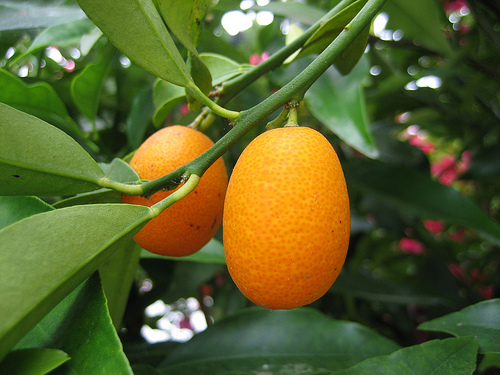Kumquats are they hidden away relatives of oranges.
- Kumquats are a type of citrus fruit that grown on small trees, that have edible skin and flesh, and they are believed to be native to China.
- ‘Kumquats’ are also known as ‘cumquats’, and the name is taken from the Cantonese word 金橘, pronounced ‘kamkwat’, which literally means ‘gold’ or ‘golden’ and ‘orange’ or ‘tangerine’.
- The official species name of a kumquat tree is Citrus japonica, from the family Rutaceae, the family of citrus, however, they were formerly of the Fortunella genus, and as such, the old scientific names for the fruit are still commonly used.
- Kumquats are typically sturdy fruit, and the plants generally have the ability to withstand fairly hot and cold growing temperatures, unlike many other citrus species.
- The flesh of kumquats is particularly strong and sour, however the skin is usually sweet in comparison, and for this reason, it is common for the flesh and skin, or ‘peel’ as it is often called, to be eaten together.
Kumquat
Image courtesy of Eugene Kim/Flickr
- Kumquats are generally of an ovoid or roughly spherical shape, depending on the variety, and they can have a diameter of around 1.6 to 4 centimetres (0.6 to 1.6 inches).
- There are four main varieties of kumquats, with the nagami variety being the most commonly grown due to its hardiness and productiveness.
- Kumquat skin changes from a green colour, to a bright orange-yellow or orange-gold colour when ripe, with colour varying according to the variety.
- Kumquats can be eaten both fresh and as a marmalade or jam, and they are sometimes dried, pickled, sugared or cooked.
- Kumquats are very high in vitamin C and are a good source of fibre, and they contain many other vitamins and minerals.
Bibliography:
Kumquat, 2016, Purdue Agriculture, https://hort.purdue.edu/newcrop/morton/kumquat.html
Kumquat, 2016, Wikipedia, https://en.wikipedia.org/wiki/Kumquat
What Is A Kumquat, 2014, Kumquat Growers, http://kumquatgrowers.com/what.html






